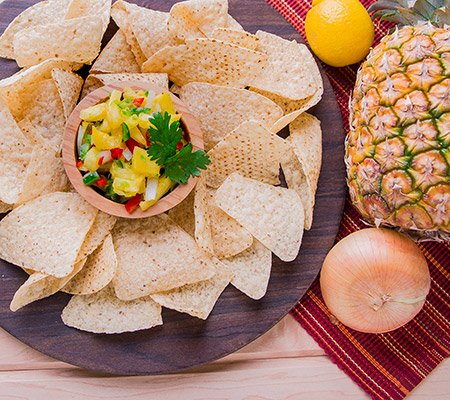
Try this Pineapple Salsa recipe, paired perfectly with grilled fish or chicken.
Pineapple, once a prized fresh fruit, is the second most popular tropical fruit, second only to the banana.
“I like everything about pineapple,” said Marshfield Clinic Health System dietitian Karla Arrigoni. “It’s sweet and juicy. It also is super versatile. It can be used in fruit or vegetable salads. It’s great on kebobs or pizza.”
Did you know?
- Pineapple contains half of the daily-recommended value of vitamin C, according to the FDA. Vitamin C is an antioxidant that fights cell damage.
- It has 75 percent of the daily-recommended value of the mineral manganese, which helps develop strong bones and connective tissue.
- Pineapple contains dietary fiber, which helps keep you regular and keeps your intestines healthy.
- Unlike many other fruits and veggies, pineapple (core) contains significant amounts of bromelain, an enzyme that breaks down protein, possibly helping digestion, according to the American Cancer Society.
History of the pineapple
Originating in Brazil, this tasty tropical fruit was discovered by Europeans in 1493 in the Caribbean. Explorers introduced them to many other parts of the world where they still are grown today.
Pineapples are quite perishable, so transporting them made them a rare, coveted, expensive treat. According to WHFoods.com, the pineapple was such a status item, all a party hostess had to do was to display a fruit as part of a centerpiece to be awarded social awe and recognition. Because of this, the pineapple came to be a symbol of hospitality.
Selecting and storing
To select a ripe pineapple, Dole recommends choosing one that is plump and fresh looking. “Fresh, green leaves in the crown are a good sign. The body should be firm – not soft. The larger the pineapple, the greater proportion of edible fruit. That doesn’t mean necessarily it is better tasting or any riper than smaller fruit. Shell color is not necessarily a sign of maturity or ripeness. Ease in pulling the leaves out of the crown is not a sign of ripeness or good quality.”
The core of the pineapple is a little harder and, obviously, not as appealing as the fleshy part of the fruit, but don’t remove it, Arrigoni said. It’s full of nutrients and fiber to keep your digestive system healthy. The core has high concentration of bromelain, compared to the fruit, and is more beneficial. You can freeze the core in slices and use it in smoothies.
Pineapple stops ripening when it is picked. It can be left on the counter for a day or two, and it will become softer and juicier, but watch closely to be sure it doesn’t spoil. To keep a fresh pineapple longer, wrap it in a plastic bag and store it in the refrigerator for three to five days.
Cut pineapple can be stored in the refrigerator in an airtight container and will stay fresher and taste better if you add some liquid, preferably juice from the pineapple.
Try this recipe
While fresh pineapple can be eaten alone, in a salad, topping yogurt or pretty much any way you can think to use fresh fruit, it also works well in recipes, giving a tropical taste to meats and salads.
“I love the idea of this pineapple salsa, especially in the summer, as it’s great served with grilled fish or chicken,” Arrigoni said.
Pineapple Salsa
Prep time: 10 minutes
Serves: 7
Ingredients
- 2 cups chopped fresh pineapple
- 1 cup chopped red and/or green bell pepper
- 1/2 cup sweet onion slivers
- 1/4 cup lemon juice
- 3 tablespoons chopped cilantro
- 1 to 2 fresh jalapeño peppers, seeded and finely chopped
Instructions
Blend pineapple, bell pepper, onion, lemon juice, cilantro and jalapeño pepper in medium bowl. For a richer taste, refrigerate, covered for 4 to 24 hours, stirring occasionally. Serve with grilled chicken or seafood or as an appetizer with chips.
Nutritional information
Each half-cup serving contains about: 35 calories, 9 g carbohydrates, 0.2 g fat, 1 g dietary fiber, 2 mg sodium and 1 g protein.
Source: Fruits and Veggies More Matters®
Print salsa recipe

Can something else be substituted for pineapple? I'm taking medications that restricts my intake of pineapple and grapefruit.
Great question, Kathy. You might try a tropical fruit, like mango.
We actually have a mango salsa recipe, if you're interested in that instead: https://shine365.marshfieldclinic.org/wellness/mango-tomato-salsa-recipe/
Thank you for reading Shine365 -Kirstie
I make the same recipe with mangos. Delicious